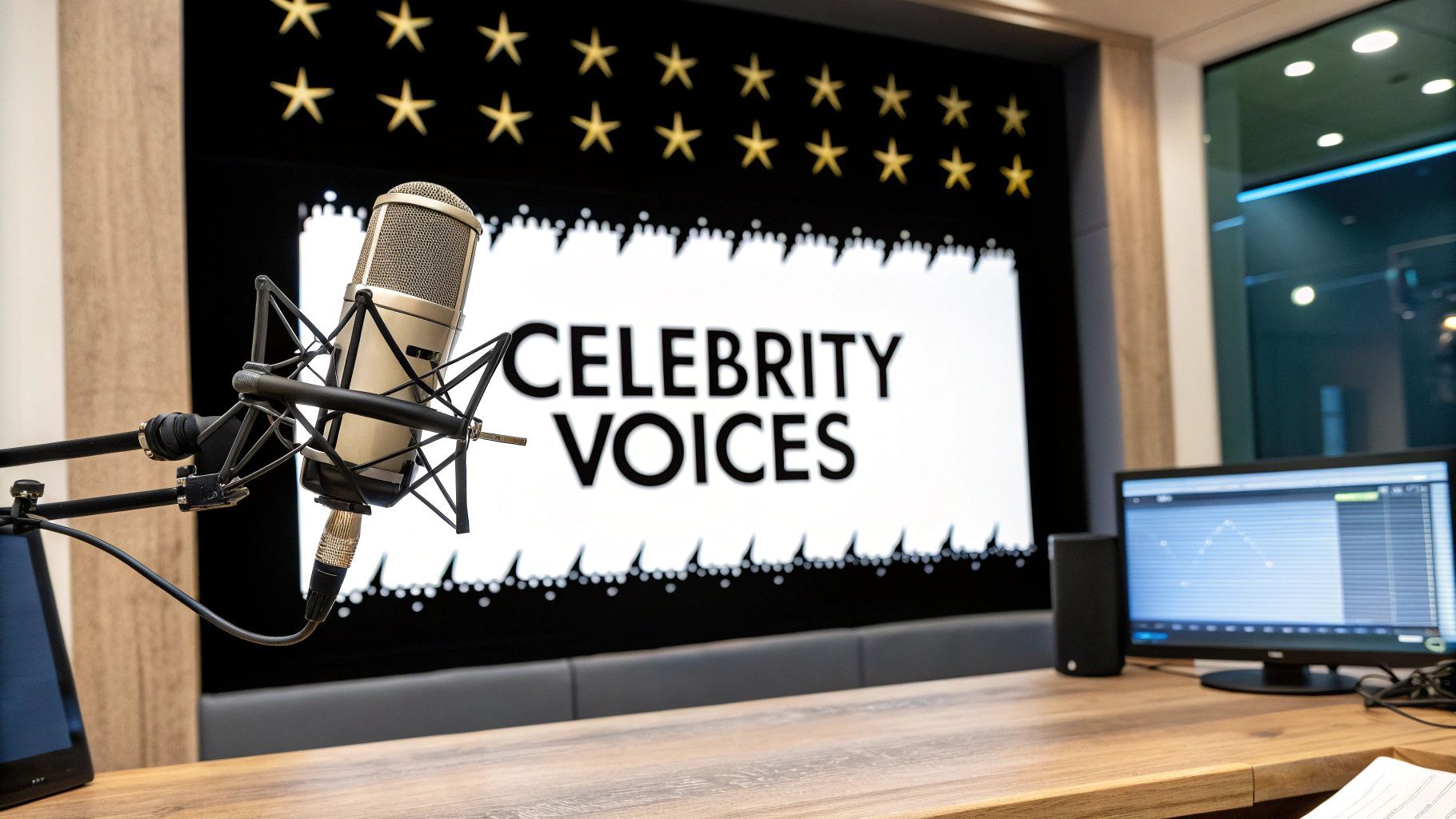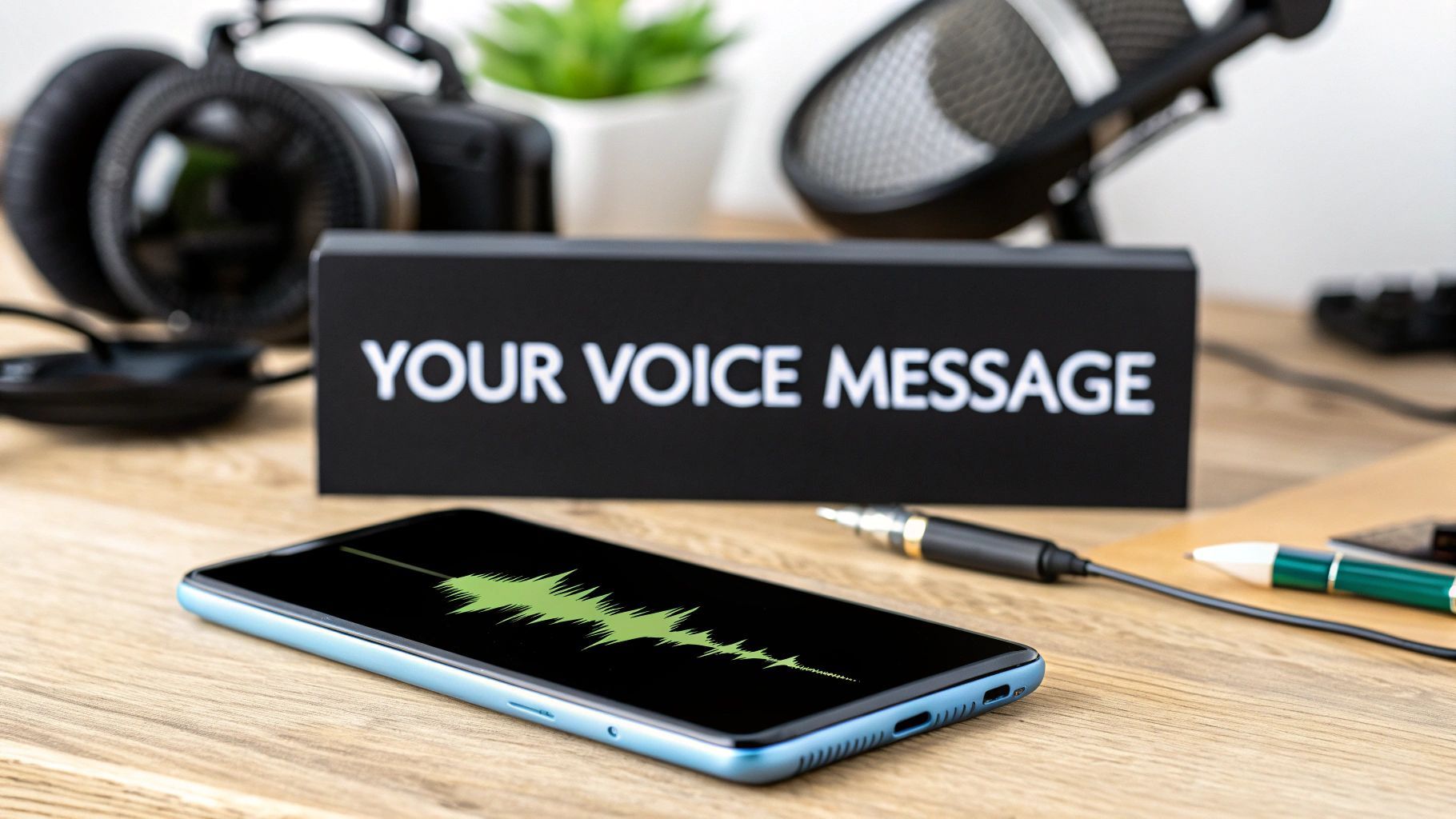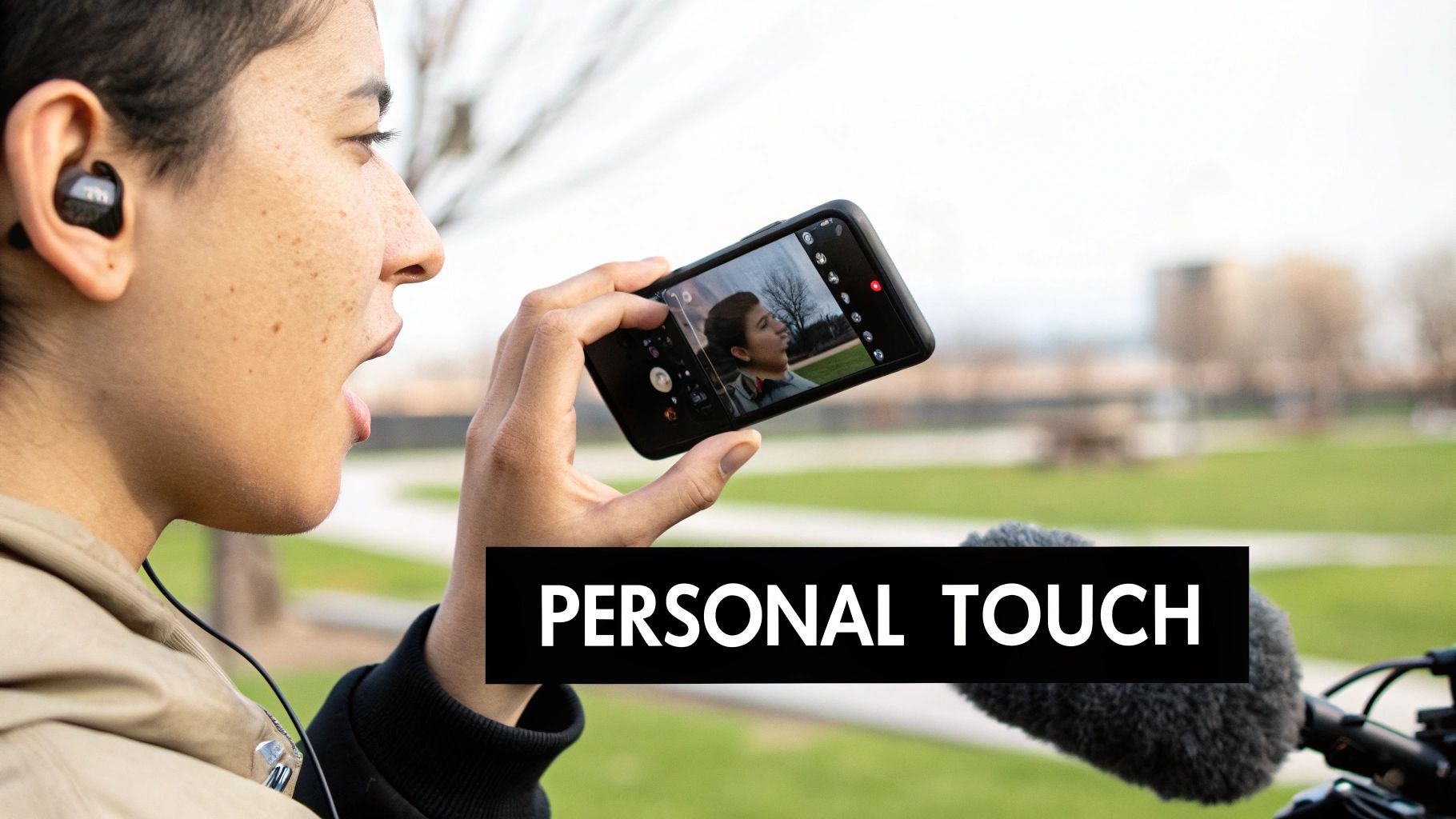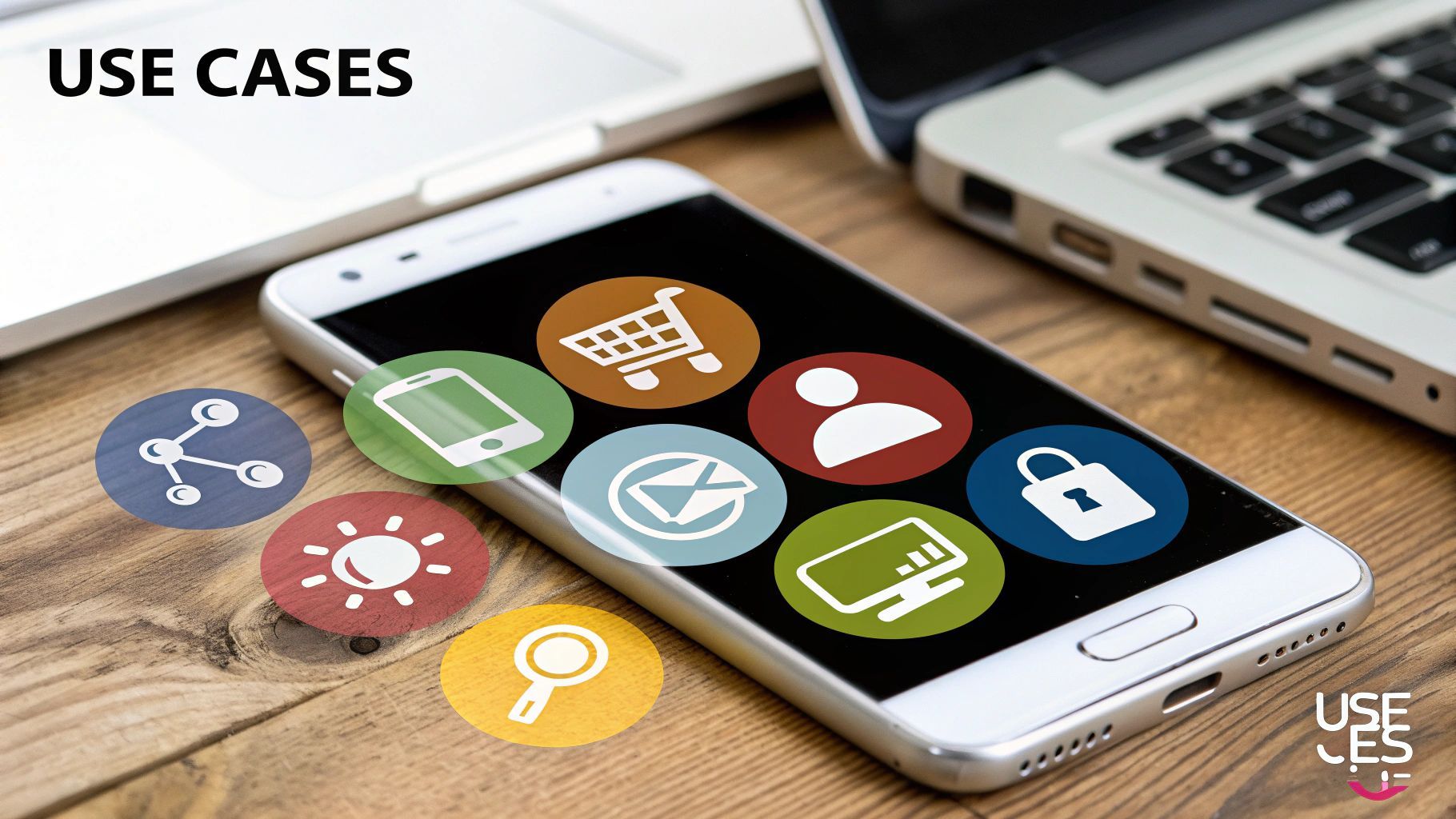Your Guide to AI Celebrity Voice Generator Tech




Discover how to create the perfect personalized voice message. Our guide explains how to use AI voice technology to boost engagement and build connections.
Let's be honest. Sending a generic email blast is like shouting into a packed stadium and hoping the one person you want to reach actually hears you. It's a long shot.
But a personalized voice message? That’s like walking right up to that person, tapping them on the shoulder, and saying their name. It's direct, it's personal, and it's almost impossible to ignore. This classic, old-school approach, now supercharged with some seriously cool tech, is the secret weapon your outreach has been missing.

In a world where we're all drowning in digital text, the sound of a human voice is a lifeline. Just think about the last time it was your birthday. You probably got a bunch of "HBD" texts. But what if a friend left you a voicemail, a little out of tune, singing "Happy Birthday"? The text just gives you the information, but the voice? That delivers the feeling.
That's the magic of a personalized voice message. It shatters the cold, impersonal barrier of our screens and forges a real, human connection. For any business, this isn't just a fluffy "nice-to-have." It’s a game-changing advantage that completely flips how people see your brand.
You know why a handwritten note feels so special? Because you know someone took the time and effort to physically write it out, just for you. A voice message bottles that same feeling for the digital world. It's a little piece of you, authentic and human, sent directly to one other person. That simple act carries a surprising amount of emotional weight.
Here’s where a voice message really leaves text in the dust:
Tone Is Everything: Text is flat. It’s so easy to misread. But a voice carries all those little things—enthusiasm, sincerity, empathy—that build instant rapport and make people trust you. It's Memorable: We're wired to remember what we hear far better than what we read. A unique voice message will stick in a customer's head way longer than yet another email they’ll archive without a second thought. It’s a Pattern Interrupt: People expect ads and outreach to be text or images. Getting an audio message is different. It’s intriguing. It makes them stop scrolling and actually listen.
A voice message isn’t just a new channel for the same old sales pitch. It's a totally different way to communicate, one that puts genuine human connection front and center.
The big hang-up in the past was always scale. How could you possibly leave a unique voicemail for a thousand different people? You couldn't.
But now, tools like SendFame have completely changed the game. Using smart AI, you can record one great, heartfelt message, and the platform will automatically customize it for every single person on your list.
This isn't about blasting out robotic-sounding robocalls. It's about making every single person feel like you picked up the phone and recorded a message just for them, using their name and other details that matter. As you learn more about personalized voice messages, you'll see how this perfect mix of real-deal authenticity and smart technology is changing what it means to connect with people.

So, how exactly does a single recording of your voice multiply into a thousand unique messages, each one sounding like it was made just for that person? It feels like magic, but it’s actually a brilliant mix of voice synthesis, machine learning, and some very smart data handling.
The easiest way to think about it is like an audio mail merge. You record the main message in your own voice, and the AI then expertly drops in the personalized bits—a customer's name, their last purchase, a specific appointment time—and makes it all sound completely natural. No awkward pauses or clunky splices.
This all hinges on a few key pieces of tech working in perfect harmony. The first is Natural Language Processing (NLP), which is the secret sauce that helps computers understand and talk like humans. It's the same stuff that makes your smart speaker understand you're asking for the weather and not a recipe for leather.
NLP gives the AI the context it needs to get the little things right. When it adds a name into your sentence, it knows how to adjust the pacing and tone so it doesn’t sound out of place. The whole point is to ditch that choppy, robotic voice of the past and create something that sounds genuinely human.
The other major player is machine learning. The AI models are fed enormous amounts of human speech data, which teaches them all the subtle quirks and rhythms of real conversation. This is what gives the final personalized voice message its authentic, easy-going feel. Want to go down the rabbit hole? We've got a great deep dive on the tech behind AI-powered text-to-speech right here.
The real breakthrough is how AI can take a genuine human recording and weave in synthesized parts without losing the original speaker's warmth and personality.
While the technology under the hood is pretty complex, the process for you is refreshingly simple. Here’s how platforms like SendFame pull it off:
Core Recording: First, you record the main part of your message, leaving gaps where the personalized info will go. Data Upload: Next, you upload your contact list with all the variables you need (first name, product, etc.). AI Synthesis: The AI listens to your voice, analyzes it, and then generates the missing pieces in a voice that perfectly matches your tone and style. Audio Assembly: Finally, the system stitches your original recording and the newly created parts together, pumping out a unique, finished audio file for every single person on your list.
This isn't just a neat party trick; it's part of a massive, growing market. The global speech and voice recognition market was valued at $15.46 billion and is on track to explode to $81.59 billion by 2032. That kind of growth is fueled by the same AI advances that make this all possible. To learn more about the broader tech, you can check out some fantastic guides on AI Calling Systems.
It’s one thing to understand the mechanics behind how AI crafts a personalized voice message, but the real magic happens when you see the results. So, why bother with voice when an email or a text is just a few clicks away?
Simple. In a world cluttered with silent, impersonal notifications, the sound of a human voice cuts through the noise. It doesn't just grab attention; it forges a real, human connection that plain old text can only dream of.
Picture a startup founder wanting to personally thank their first 100 customers. A generic "thank you" email? It's fine, but it’s also forgettable and expected. Now, imagine each of those customers gets a warm, friendly voice message from the founder—by name—maybe even mentioning the product they bought. That’s not just a thank-you note; it’s the start of a loyal community. It makes people feel genuinely appreciated, turning a routine transaction into something they’ll remember and talk about.
The numbers don't lie. While a good email campaign might get a 20% open rate, a voice message is almost guaranteed to be heard. In fact, studies show voice messages can pull in response rates 30% higher than emails.
And it gets even better. Some personalized campaigns have seen callback rates jump by a staggering 300% compared to those generic, pre-recorded messages. This isn't just a minor bump; it's a completely different league of engagement.
Of course, how you sound matters just as much as what you say. This image breaks down how crucial audio quality is to the listener's experience.

As you can see, stepping up from a basic smartphone mic to a decent USB or professional microphone makes a huge difference. That leap in audio quality makes your message sound crisp, professional, and ultimately, far more convincing.
Let's put this into perspective. How does a personalized voice message really stack up against the old standbys of email and SMS?
| Metric | Personalized Voice Message | Standard Email | Standard SMS |
|---|---|---|---|
| Open/Listen Rate | ~90% | ~20% | ~98% (but often ignored) |
| Response Rate | ~8-12% | ~1-2% | ~5-6% |
| Conversion Rate | Significantly Higher | Lower | Moderate |
| Personal Connection | Very High (Human Voice) | Low (Impersonal) | Low (Transactional) |
| Cut-Through | High | Very Low | Moderate |
While SMS boasts a high open rate, its transactional nature often leads to lower engagement. Voice messages, on the other hand, combine a near-perfect listen rate with the personal touch that actually inspires people to act.
This move toward audio isn't just a fleeting trend. The global market for voice-activated applications—the very tech that makes this possible—is projected to explode to USD 87.5 billion by 2034. That's an astonishing growth rate of 30.8% every single year.
This rapid expansion signals a massive cultural shift. People are getting more comfortable and reliant on voice interactions in their daily lives, making it the perfect channel to build a meaningful connection. You can dive into the data and see just how big this voice-activated market trend is becoming.
Choosing a personalized voice message is like choosing to have a real conversation instead of just passing a note. One builds a relationship; the other just passes information.
When you boil it all down, the conclusion is crystal clear. Email and SMS are great for broadcasting information to the masses, but when it comes to forging genuine connections, voice is the undisputed champion. It consistently outshines text-based methods across every important metric, from grabbing attention to driving conversions.
Alright, you’ve seen how powerful voice messages can be. Now, let's talk about how to get clever with them. A personal voice note isn't just another marketing gimmick; it's your secret handshake in a world of automated, cookie-cutter communication. It’s how you make someone stop scrolling and actually listen.
Whether you're running a bustling online store or a non-profit trying to change the world, the possibilities here are pretty much endless. Using a platform like SendFame lets you take these ideas off the whiteboard and into the real world, building genuine relationships one voice memo at a time. Let's dive into some practical plays you can run.
Let’s be honest, sales is all about getting noticed. Your competition is flooding inboxes with those generic "just circling back" emails that are destined for the trash folder. You can be different. Imagine dropping a friendly, personalized voice message right into a prospect’s voicemail instead. It’s a total pattern-interrupt that immediately sets you apart.
Picture this: you're following up with a lead named Sarah who just downloaded one of your guides.
"Hey Sarah, it's Alex from [Your Company]. I noticed you grabbed our guide on boosting social media engagement and just wanted to pop in with a quick thought. Hope you're finding it useful!"
See? It’s human. It's not pushy. And it’s a whole lot harder to ignore than another block of text. It proves you took a moment to make a real connection, which can seriously boost your odds of getting that all-important callback.
The relationship you have with a customer shouldn’t just end when they click "Complete Purchase." A quick, personal voice message can transform a routine transaction into a memorable experience, creating the kind of brand loyalty that keeps people coming back.
Think about hitting these key moments:
A Post-Purchase Thank You: Imagine a new customer getting a message from the founder, by name, thanking them for their first order. That’s a huge "wow" moment. Shipping Updates with a Smile: Ditch the cold, robotic text. A friendly voice saying, "Hey Mark, just wanted to let you know your new headphones are officially on their way!" adds a warm, personal touch that people remember. Asking for Feedback: A genuine voice asking for a review feels less like a corporate survey and more like a friend asking for your honest opinion.
Getting sign-ups is only half the battle. The real trick is getting people to actually show up. A voice message is the perfect way to send a last-minute reminder that feels exciting and personal—not just another calendar notification to be swiped away.
Try sending something like this the day before your big webinar:
"Hi Jamie, just a friendly heads-up that our webinar on AI-powered marketing kicks off tomorrow at 2 PM. We’ve got some amazing stuff to share, and I'm really looking forward to seeing you there!"
That simple, human touch can be the difference between a half-empty virtual room and a full house. For artists and creators, these tactics are pure gold. To get more ideas on this front, check out our guide on how to promote music online and start building real buzz. It all comes down to creating that personal connection that makes your audience feel like they're part of something special.
Alright, enough talk. Let's get our hands dirty and actually build your first SendFame campaign. This is where the rubber meets the road, and you'll see just how easy it is to get your voice out there.
We've designed the whole process to be straightforward. No need for a degree in computer science—just a clear message and a list of people you want to reach.
This is mission control. The SendFame dashboard is clean and simple, making it a breeze to find exactly what you need, whether that's AI Celebrity Videos or, in our case, the voice campaign tools.
Let’s walk through it.
First things first, you need to record the main part of your message. This is the chunk of audio that everyone on your list will hear. Think of it as the consistent, friendly core of the conversation you're about to have with hundreds (or thousands) of people.
Don't sweat the script too much. The best messages sound like you’re leaving a voicemail for a buddy, not reading from a teleprompter. Just be yourself, speak clearly, and let your natural warmth shine through.
Pro Tip: Keep it snappy. We're talking 30-45 seconds, max. Why? Voicemails under 30 seconds actually get a 12% higher callback rate. Get in, get to the point, and get out. It shows you respect their time.
Now for the fun part—the personalization. You’ll need a simple spreadsheet (a CSV file works perfectly) with your contacts' phone numbers and any other bits of info you want the AI to weave into the message.
This is where you can get creative. Your spreadsheet columns could include things like:
First Names: So you can open with a casual, "Hey, Sarah!" Appointment Times: Perfect for sending out super-helpful reminders. Product Names: To mention something they recently bought.
Every column is a potential variable. The AI uses this data to cook up a unique, personalized voice message for each and every contact. Just make sure your spreadsheet is tidy before you upload it.
Got your audio? Got your list? You're ready to fly.
Inside SendFame, you'll just point the system to your audio file, upload your contact list, and then tell it which spreadsheet column goes with which variable in your message. It's like a simple matching game.
Once you hit that big "send" button, the system takes over. It starts creating and dialing, delivering a perfectly customized message to everyone on your list. Now you can lean back and check the campaign dashboard. You'll see real-time stats on delivery rates, how many people listened, and who called you back. All that data is gold for making your next campaign even better.

Anyone can hit record and ramble into their phone. But crafting a personalized voice message that genuinely lands? That’s where the real magic happens. It's the difference between a message that gets deleted and one that feels like a personal, one-on-one chat.
You're aiming for something that isn't just heard but is truly felt. To pull that off, you have to get the basics of timing, tone, and delivery just right.
Let's be honest, nobody wants to listen to a long-winded corporate voicemail. Your goal is to send a friendly, personal memo that respects their time.
A great rule of thumb is to keep it under 30 seconds. In fact, research shows that shorter voicemails pull in a 12% higher callback rate than their longer cousins. Jump straight to the good stuff, show them the value, and wrap it up with a clear next step.
Think of your voice message as the hook. You’re not trying to tell the whole story in one go. You’re just trying to get them curious enough to want to hear the rest.
This tight, punchy approach makes sure your main point hits home before their attention wanders, making a response far more likely.
Your tone is everything. It’s what transforms a cold, robotic pitch into a memorable, human connection. So, speak naturally and let some genuine enthusiasm come through in your voice.
To get the best results, keep these two things in mind:
Be Authentic: Ditch the rigid script. Know your key points, sure, but let your personality do the talking. Artists can learn more about using their unique voice in our guide on AI tools for musicians.Ensure Clarity: Your audio has to be crystal clear. Nothing kills a great message faster than a wall of background noise or annoying static.
As voice messaging becomes more popular, keeping things secure is more important than ever. This is where cool tech like voice biometrics comes in, which uses unique vocal traits like your pitch and tone to verify who you are.
This isn't some niche concept, either. The global voice biometrics market is currently valued at a whopping USD 2.39 billion and is expected to nearly triple to USD 7.01 billion by 2032. By preventing fraud, this technology helps build a solid foundation of trust with your audience, making your personalized messages feel both safe and special.
Got a few questions rattling around in your head about how this whole personalized voice message thing works? You're not alone. Let's tackle some of the most common ones I hear.
I get it, the first thing that comes to mind is probably that clunky, robotic voice from old sci-fi movies. But today's AI and text-to-speech (TTS) tech is a whole different ball game.
Think of it like an actor who has spent a lifetime studying human conversation. These AI models are trained on massive libraries of real human speech, allowing them to pick up on the subtle stuff—the pauses, the changes in pitch, the rhythm—that makes a voice sound genuinely human. It's less about just reading words and more about understanding and delivering the emotion behind them.
Surprisingly, no. When you look at the bang for your buck, it's actually one of the most cost-effective strategies out there.
Your cost per message is tiny, especially when you stack it up against the time and money burned on old-school outreach like manual cold calling. Tools like SendFame make it incredibly affordable to add that personal, human-sounding touch to your communication, even when you're reaching hundreds or thousands of people.
A personalized voice message campaign often delivers a much higher ROI than traditional channels. Why? Because it slices right through the digital noise and gets a real, direct response, making every dollar you spend work that much harder for you.
Okay, this one is super important. Compliance is everything.
You absolutely need to be aware of regulations like the TCPA in the United States, which has strict rules about automated calls—mainly, you often need someone's permission first. But here's the key difference: a personalized message sent to an existing customer or a warm lead who expects to hear from you is worlds away from a generic robocall blasted out to a cold list. It's all about context and consent.
Ready to make your voice heard? You can create some truly unforgettable, hyper-realistic messages with SendFame and see for yourself just how easy it is to build a real connection. Kick off your first campaign today at https://sendfame.com.
Create Epic
SendFame